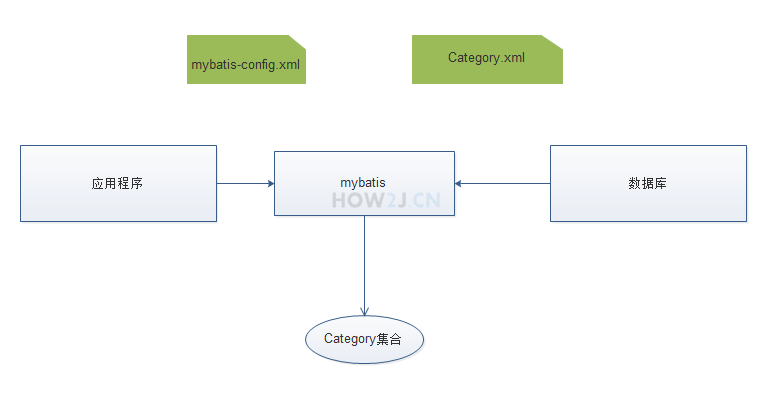Mybatis笔记01-基本原理,配置文件,映射文件,以及调用过程
Mybatis基本原理

- 应用程序找Mybatis要数据
- mybatis从数据库中找来数据
2.1 通过mybatis-config.xml 定位哪个数据库
2.2 通过Category.xml执行对应的select语句
2.3 基于Category.xml把返回的数据库记录封装在Category对象中
2.4 把多个Category对象装在一个Category集合中
- 返回一个Category集合
mybatis-config.xml,mybatis配置文件
<?xml version="1.0" encoding="UTF-8" ?>
<!DOCTYPE configuration
PUBLIC "-//mybatis.org//DTD Config 3.0//EN"
"http://mybatis.org/dtd/mybatis-3-config.dtd">
<configuration>
<typeAliases>
<package name="com.how2java.pojo"/>
</typeAliases>
<environments default="development">
<environment id="development">
<transactionManager type="JDBC"/>
<dataSource type="POOLED">
<property name="driver" value="com.mysql.jdbc.Driver"/>
<property name="url" value="jdbc:mysql://xxxx?characterEncoding=UTF-8"/>
<property name="username" value="root"/>
<property name="password" value="admin"/>
</dataSource>
</environment>
</environments>
<mappers>
<mapper resource="com/how2java/pojo/Category.xml"/>
</mappers>
</configuration>
<typeAliases>
<package name="com.how2java.pojo"/>
</typeAliases>
自动扫描com.how2java.pojo下的类型,使得在后续配置文件Category.xml中使用resultType的时候,可以直接使用Category,而不必写全com.how2java.pojo.Category
<mappers>
<mapper resource="com/how2java/pojo/Category.xml"/>
</mappers>
映射Category.xml
<mapper namespace="com.how2java.pojo">
<select id="listCategory" resultType="Category">
select * from category_
</select>
</mapper>
id= "listCategory" 进行标示以供后续代码调用
resultType="Category" 表示返回的数据和Category关联起来,这里本应该使用的是 com.how2java.pojo.Category, 但是因为上一步配置了别名,所以直接使用Category就行了
<select id="getCategory" parameterType="_int" resultType="Category">
select * from category_ where id= #{id}
</select>
parameterType:参数类型,可为简单类型或对象类型
resultType:返回类型
调用测试
package com.how2java;
import java.io.IOException;
import java.io.InputStream;
import java.util.List;
import org.apache.ibatis.io.Resources;
import org.apache.ibatis.session.SqlSession;
import org.apache.ibatis.session.SqlSessionFactory;
import org.apache.ibatis.session.SqlSessionFactoryBuilder;
import com.how2java.pojo.Category;
public class TestMybatis {
public static void main(String[] args) throws IOException {
String resource = "mybatis-config.xml";
InputStream inputStream = Resources.getResourceAsStream(resource);
SqlSessionFactory sqlSessionFactory = new SqlSessionFactoryBuilder().build(inputStream);
SqlSession session=sqlSessionFactory.openSession();
List<Category> cs=session.selectList("listCategory");
for (Category c : cs) {
System.out.println(c.getName());
}
}
}
根据配置文件mybatis-config.xml得到sqlSessionFactory
String resource = "mybatis-config.xml";
InputStream inputStream = Resources.getResourceAsStream(resource);
SqlSessionFactory sqlSessionFactory = new SqlSessionFactoryBuilder().build(inputStream);
然后再根据sqlSessionFactory 得到session
SqlSession session=sqlSessionFactory.openSession();
最后通过session的selectList方法,调用sql语句listCategory。listCategory这个就是在配置文件Category.xml中那条sql语句设置的id。
执行完毕之后,得到一个Category集合,遍历即可看到数据。
List<Category> cs = session.selectList("listCategory");
for (Category c : cs) {
System.out.println(c.getName());
}
resultMap包含的元素:
<!--column不做限制,可以为任意表的字段,而property须为type 定义的pojo属性-->
<resultMap id="唯一的标识" type="映射的pojo对象">
<id column="表的主键字段,或者可以为查询语句中的别名字段" jdbcType="字段类型" property="映射pojo对象的主键属性" />
<result column="表的一个字段(可以为任意表的一个字段)" jdbcType="字段类型" property="映射到pojo对象的一个属性(须为type定义的pojo对象中的一个属性)"/>
<association property="pojo的一个对象属性" javaType="pojo关联的pojo对象">
<id column="关联pojo对象对应表的主键字段" jdbcType="字段类型" property="关联pojo对象的主席属性"/>
<result column="任意表的字段" jdbcType="字段类型" property="关联pojo对象的属性"/>
</association>
<!-- 集合中的property须为oftype定义的pojo对象的属性-->
<collection property="pojo的集合属性" ofType="集合中的pojo对象">
<id column="集合中pojo对象对应的表的主键字段" jdbcType="字段类型" property="集合中pojo对象的主键属性" />
<result column="可以为任意表的字段" jdbcType="字段类型" property="集合中的pojo对象的属性" />
</collection>
</resultMap>



